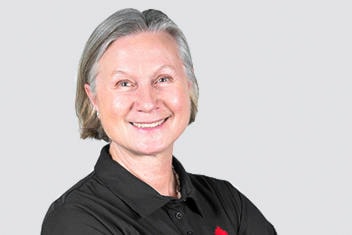Vicki Harber is hoping to make an impact outside the lines at the 2019 Canada Winter Games.
Harber, who has a PhD, is Professor Emeritus at the University of Alberta from the Faculty of Physical Education & Recreation and one of several panelists who has been invited to speak at Coach House in the Athlete’s Village at the Games.
Along with former NHLer Sheldon Kennedy, the duo discussed keeping girls in sport and recognizing women who coach in their Monday night fireside chat.
Harber, who is helping shape athlete development programs for young females across Canada was also here last week as part of the panel put on by the Coaching Association of Canada during Week one. She said the focus inevitably shifted to what the research is saying about how to keep girls involved in sport between the ages of 12 to 16.
Research on the topic is plentiful, she noted sometimes it can be as simple as finding a mentor, whether it is an adult or even an older student.
Another major factor in the dropout rate, or even getting girls involved in the first place is the notion sport is only for high-level competition. Harber said the community building aspect of sport is sometimes overlooked in our ultra-competitive society. When in reality, it could be a place for us to focus our attention if we want to keep young athletes involved longer.
“I think sport has lost its way a little bit, particularly community sport. Around making it more than just the high-performance pathway,” Harber said.
“We get extremely fixated on excellence at way too young an age. Girls in particular, because of some of their social circumstances – if they don’t feel like they’re a star performer, why the heck would they put themselves in that situation to begin with.”
That all is affected by coaching, which Harber noted is an important piece of the conversation as well. Not just high-level, elite coaches who push athletes to the podium, but ones who stress team and community building, hard work and dedication at all levels. That will help make better coaches down the road, but also younger mentors in sport for their peers.
“If they’ve had quality experiences and a coach that can help them feel a sense of belonging and this value piece. Not every athlete is going to be able to wear red and white or provincial colours. How can a coach create a culture that everyone can contribute?” Harber asked.
“We’ve heard stories along the way about athletes who haven’t made it into those higher levels of performance, but because of a wise coach will say, ‘I think you’ve got a really good eye for the game or you’ve got strong communication style, have you ever thought of coaching?’ ”
In the end, the conversations around sport, good and bad, are helping organizations, coaches and athletes alike. Advancing the conversation forward in order to push the boundaries about making sports a better place for everyone, is as important as the lessons learned along the way.
“The more we have conversations about it, I think the more normalized the whole thing becomes. We’re in some lightning rod times with various issues around sport and treatment of girls and young athletes,” she said.
“There’s no shortage of areas in which we can create dialogue over and as long as they are approached with some open minds, we can’t help but make things better.”
Email sports tips to Byron Hackett
Like us on Facebook and follow us on Twitter
